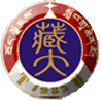Tibet ShoppingA trip to Tibet is never complete without a long shopping spree. Shopping in Tibet, over the time has generated great interest in travelers and now people often travel to Tibet for its shopping bonanza. That's how fascinating and unique the experience of shopping in Tibet is. Shopping usually starts from Lhasa where people get everything, from a pin to a palace, and then move onto places that are unique for their specialties.
Tibetan Paintings Tibet is actually famous for its paintings. There are a variety of painting travelers can choose from, such as religious and contemporary. Tibetan Liquor Tibetan distilled liquor is a sort of light alcohol made of wheat or highland barley through fermentation, which tastes weak and mellow, and the alcohol is about 20-30 degrees strong. The distilled liquor of Mangkang County in east Tibet and Yadong County at the border area is famous for its distinctive features. 
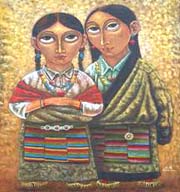
Milk Products The most popular kinds of milk in Tibet are sour milk and milk scrap. However there are two sorts of sour milk, one is cheese, which is made of milk that has been used to extract ghee, the other is made of milk which has not been used to extract ghee. Sour milk is the food after it has been saccharified. This kind of milk is more nutritious and easy to digest, especially for the old and the young. Milk scrap is the substance after the milk has been refined to make Su butter, and it is formed by cooking and evaporating. Milk products are the important food of Tibetan. The Tibetans always keep them at home or take them with themselves when going outside for food. In Tibet, where there are few between meal nibbles, the adults always give children milk scrap as between meal snacks. Tibetan Cashmere Shawls
Tibetan Blankets The nomad blankets are woven from yak hair or goat hair. The weavers use hair of several different colors, with the occasional addition of a dyed stripe, so the blankets have a unique texture. They are strong enough to use on the floor.
There are numerous varieties of jewelry like pearls, agate, gold and silver ornaments attracting visitors to purchase. Tibetan Medicine
Dating back 2500 years, the Tibetan medical tradition has developed its own unique healing practices. In the 8th century, the renowned Tibetan physician, Yutok Yonten Gonpo, produced the Four Medical Tantras, known as Goo-Shee, after combining the medical knowledge of Tibet with that of China, India, Nepal and Persia. Yutok Yonten Gonpo's descendant, the younger Yuthok, wrote eighteen supplemental medical works at which time the traditional principles of Tibetan medicine had been established. Mentsekhang (the Tibet Traditional Hospital), founded in 1916 is the Tibetan physicians' training center.
Braided Tibetan Textile These textiles are made without a loom. The maker simply begins with a bundle of heavyweight yarns and a needle, and proceeds to interweave the yarns to make a kind of braiding. A larger piece takes about 6 weeks to make.
Lhasa Department Store
Barkhor
Shopkeepers sell items such as prayer flags, Buddha figures, conch-shell trumpets, rosaries, amulets, fur hats, horse bells, bridles, copper teapots, wooden bowls, inlaid knives, and jewelry inlaid with turquoise and other gems. Tourists should carefully examine jewelry for quality. While much jewelry of excellent quality is available, some are coarsely done. But still, unique designs and cheap rates make them great souvenirs that travelers can take back home. Visitors can easily find items that are uniquely Tibetan and very appealing. Exotic Tibetan opera masks and costumes are interesting items. Brightly colored, beautifully homespun Tibetan rugs and khaddar are also popular souvenirs. Tibetan carpet can be bought at the Lhasa Carpet Factory. Tibetan tents can be bought at the Lhasa Tent and Banner Factory. As in traditional markets throughout much of the world, visitors can bargain with the local people and buy nice things at lower prices, and the same time be accompanied by hundreds of prostrating pilgrims. This is a thrilling experience that will certainly remind you that you are in Lhasa.
There are three Xinhua Bookstores in Lhasa. One is on Yuthok Lu, another is on east Barkhor Street, and the third is on Beijing Zhong Lu, west of Tibet Hotel in Lhasa. Xinhau Bookstores sell maps of Lhasa, Tibetan primers, Tibetan-Chinese dictionaries, and Tibetan and Chinese books. There is also a bookshop that carries Tibetan literature on north Barkhor Street. |

 Superb shawls made from Tibetan cashmere from Pashmina goats living on the Tibetan plateau, spun and handwoven in Tibet
makes an excellent souvenir or gifts for friends and family. Those who are creatively inclined often purchase these
shawls as a way to decorate their home.
Superb shawls made from Tibetan cashmere from Pashmina goats living on the Tibetan plateau, spun and handwoven in Tibet
makes an excellent souvenir or gifts for friends and family. Those who are creatively inclined often purchase these
shawls as a way to decorate their home. The Lhasa blanket is woven in the old town in Lhasa from Tibetan wool. They are woven in strips on
a narrow loom, then sewn together to make a full size blanket. Many customers use them as "throws"
to add color. Their beauty comes from the accidental juxtaposition of the colored bands, making each
one different.
The Lhasa blanket is woven in the old town in Lhasa from Tibetan wool. They are woven in strips on
a narrow loom, then sewn together to make a full size blanket. Many customers use them as "throws"
to add color. Their beauty comes from the accidental juxtaposition of the colored bands, making each
one different. Tibetan Jewelry
Tibetan Jewelry 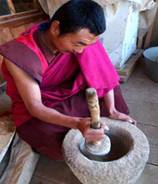 As one of the oldest medical traditions in the world, Tibetan medicine is gradually being brought into
the limelight as Tibetan culture draws much public attention both at home and abroad.
As one of the oldest medical traditions in the world, Tibetan medicine is gradually being brought into
the limelight as Tibetan culture draws much public attention both at home and abroad.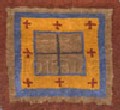
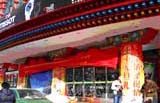 The Lhasa Department Store, a general department store, is located on the west end of Yuthok Lu.
It is the largest and best known department store in Lhasa. It sells such practical items as cotton
clothing, mugs, canned food, towels, and toothpaste, plus local handicrafts. There are also
supermarkets in Lhasa. It is suggested to buy whatever practical items needed in Lhasa, before
travelers leave for more remote towns.
The Lhasa Department Store, a general department store, is located on the west end of Yuthok Lu.
It is the largest and best known department store in Lhasa. It sells such practical items as cotton
clothing, mugs, canned food, towels, and toothpaste, plus local handicrafts. There are also
supermarkets in Lhasa. It is suggested to buy whatever practical items needed in Lhasa, before
travelers leave for more remote towns. Barkhor is a more traditional Tibetan shopping market. It is a
market where shopkeepers with small shops and stalls on the street
sell many unusual and fascinating items, for both religious and
secular uses.
Barkhor is a more traditional Tibetan shopping market. It is a
market where shopkeepers with small shops and stalls on the street
sell many unusual and fascinating items, for both religious and
secular uses. 